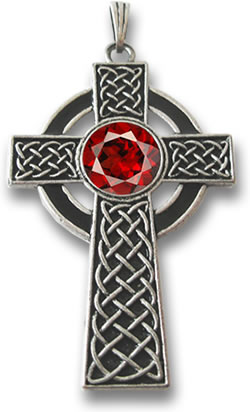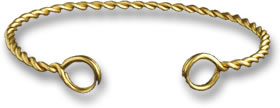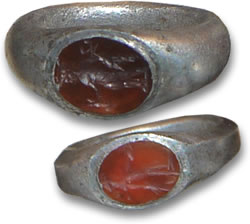귀하의 세부 정보
귀하의 세부 정보
|
검토자 Andreas Zabczyk
Celtic Jewelry Silver Celtic Cross and Pyrope Garnet Pendant
The Celts were various groups of people who lived in Central and Northern Europe during the Iron Age. The Celts are believed to have flourished in England before Roman times. Evidence of the way of life of the Celts in ancient Greek and Roman writings relates stories of wine-swilling, gold-loving, head-hunting tribes, who fought enemies naked, except for gold torcs and arm decorations. The Greek historian, Polybius, wrote of the Battle of Clastidium, where naked Celtic warriors, adorned with gold collars and bracelets were defeated by Romans. Another Greek historian called Ephorus wrote that the Celtic men carefully watched their weight, since young men were punished for having pot bellies. The Celts were fond of jewelry and this is evident in the discovery of artifacts which include necklaces, rings, armbands, bracelets and other ornaments made of bronze, gold, Baltic amber and various other decorative materials. Some of the most beautiful Celtic artifacts are gold torcs (also spelled torq or torque), which are stiff necklaces, usually with openings at the front and occasionally featuring hooks or hook and ring fastenings. The name torc, comes from the Latin torqueo, meaning "twist". Indeed, some torcs were twisted and others were smooth and solid; some were made from hollow tubes. Torcs could be simple or ornate, with intricate decorations of animals. It is thought that torcs were worn almost constantly, since some would have been difficult to remove. Torcs were a status symbol and the most prominent item of Celtic jewelry. Bracelets were also quite important, followed by anklets and armlets. Rings were not as common.  Celtic Gold Torc
One of the Celtic tribes, the Iceni people, was ruled by a queen known as Boudicca (also spelled Boadicea), who fought the Romans, but was later defeated, flogged and forced to witness her two daughters' public rape and torture. Administrator and historian, Cassius Dio reported that she was a large and imposing lady, with a mass of long, red hair, a spear in her hand and a golden torc around her neck. Celtic jewelry was characterized by curvilinear forms and geometric patterns featuring natural figures such as animals and plants. Even Celtic gods were depicted wearing adornments, such as a horned god known as Cerunnos, who wore a torc on each horn. The religious leaders of the Celts were known as Druids, who were accomplished rote scholars. The Romans wrote of gruesome Druid animal and human sacrifices, and cannibalism. The preserved remains of a man found in a peat bog (Lindow Man) in the 1980s and skeletons found in a cave in Alveston suggest that these sensational reports were true. The Druids have long been associated with the stone circle of Stonehenge in Britain. However, although Stonehenge was thought to have been used as a Druid temple, it is believed to have been constructed before the Druids, during the Neolithic period.  Celtic Rings Set with Engraved Carnelian Gems
Although the Celts were defeated by the Romans and then integrated, they did not die out. The term "Celt" was later used to refer to groups of people, such as the Bretons, Cornish, Irish, Manx, Scots and Welsh. They identified themselves as Celts in resistance to Anglicization. This led to the re-emergence of Celtic crosses, especially as 19th century headstones in church cemeteries. The Celtic cross (see, top image) may have originally been associated with the sun, the four elements or compass points; the original meaning is not clear. The Celtic cross was later adopted by the Christian church. It is said that the church used it as a way to persuade the Druids to convert. According to some Christians, the circular part of the cross represents eternity. Celts were romanticized by nationalistic Irish poets, such as W.B Yeats, at the turn of the 20th century. To this day, certain areas of the British Isles are considered to be Celtic due to their linguistic and cultural roots. Therefore, Celtic art and jewelry is very much alive and Celtic styles can be seen in contemporary body art and jewelry. |
